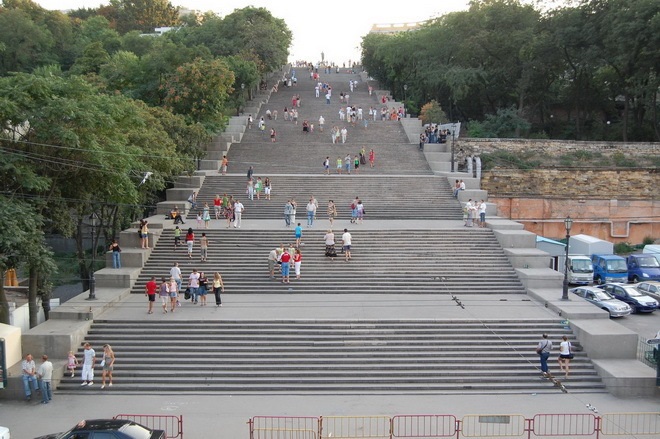The Potemkin Stairs, or Potemkin Steps (Ukrainian: Потьомкінські сходи, Potj'omkins'ky Skhody, Russian: Потёмкинская лестница, Potyomkinskaya Lestnitsa) is a giant stairway in Odessa, Ukraine. The stairs are considered a formal entrance into the city from the direction of the sea and are the best known symbol of Odessa.[1] The stairs were originally known as the Boulevard steps, the Giant Staircase,[3] or the Richelieu steps.[4][5][6][7] The top step is 12.5 meters (41 feet) wide, and the lowest step is 21.7 meters (70.8 feet) wide. The staircase extends for 142 meters, but it gives the illusion of greater length.[8][9][10] The stairs were so precisely constructed as to create an optical illusion. A person looking down the stairs sees only the landings, and the steps are invisible, but a person looking up sees only steps, and the landings are invisible
Odessa, perched on a high steppe plateau, needed direct access to the harbor below it. Before the stairs were constructed, winding paths and crude wooden stairs were the only access to the harbor.
The original 200 stairs were designed in 1825 by Italian architect Francesco Boffo and St. Petersburg architects Avraam I. Melnikov and Pot'e .The staircase cost 800,000 rubles to build.
In 1837, the decision was made to build a "monstrous staircase", which was constructed between 1837 and 1841. An English engineer named John Upton supervised the construction. Upton had fled Britain while on bail for forgery.[13] Upton went on to oversee the construction of the huge dry-docks constructed in Sevastopol and completed in 1853.
Greenish-grey sandstone from the Austrian port of Trieste (now in Italy) was shipped in.
The Potemkin Stairs as seen in The Battleship Potemkin
As erosion destroyed the stairs, in 1933 the sandstone was replaced by rose-grey granite from the Boh area, and the landings were covered with asphalt. Eight steps were lost under the sand when the port was being extended, reducing the number of stairs to 192, with ten landings












